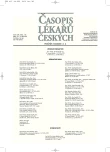Practical Aspects and Clinical Value of t(14;18) Monitoring in Peripheral Blood of the Follicular Lymphoma Patients
Authors:
A. Janíkováobořilová 1; J. Mayer 1; D. Dvořáková 1; P. Mejstřík 1; M. Navrátil 1; I. Vášová 1; L. Křen 2; M. Matuška 3
Authors‘ workplace:
Interní hematoonkologická klinika FN, Brno
1; Patologicko–anatomický ústav FN, Brno
2; Onkologické oddělení FN, Ostrava
3
Published in:
Čas. Lék. čes. 2007; 146: 374-381
Category:
Original Article
Overview
Background.
Evaluation of practical value of monitoring t(14;18) in peripheral blood in follicular lymphoma.
Methods and Results. t(14;18) was tested in 115 follicular lymphoma patients by methods:
FISH, nested and multiplex PCR of blood, bone marrow and lymph node specimens. We tested the patients with rearrangement MBR quantitatively by real-time PCR. Testing intervals of t(14;18) in peripheral blood were 1 month during treatment, 2–3 months during the first year after the end of treatment, then every 4 to 6 months. Patients were clinically examined in the same intervals and regular restaging was done by CT/PET. Each patient was evaluatee separately. Total detection of t(14;18) was 97 % regardless tissue and methods of detection, FISH was superior to PCR (95 % vs 72 %). The higher number of copies were observed in lymph nodes in comparison to bone marrow (p=0,036) and peripheral blood (p=0,016); 46/115 (40 %) patients were positive for MBR, we followed up behaviour of t(14;18) in peripheral blood in 33 of them in long intervals (>6 months, med. 33 months). Molecular and clinical courses correlated in 20/33 (61 %) patients, 7/33 (21 %) clinically relapsed in lasting molecular remission. We found very short interval to clinical relaps in 7 cases of molecular relapses (0–5 months, median 3 months). We could not define “threshold quantity” of clinically important molecular relaps. Lasting molecular remission was associated with clinical in about 60 % cases; lasting molecular activity corresponded with clinical relaps in 86 % patients.
Conclusions.
t(14;18) is highly associated with follicular lymphoma. In practice, monitoring of t(14;18) is feasible only in part of patients. Even if there is some correlation of clinical and molecular course, monitoring of t(14;18) in blood bears only limited prognostic value for the concrete patient. The treatment of patient can not be accomplished on the basis of these results only.
Key words:
follicullar lymphoma, t(14;18), bcl-2/IgH.
Labels
Addictology Allergology and clinical immunology Angiology Audiology Clinical biochemistry Dermatology & STDs Paediatric gastroenterology Paediatric surgery Paediatric cardiology Paediatric neurology Paediatric ENT Paediatric psychiatry Paediatric rheumatology Diabetology Pharmacy Vascular surgery Pain management Dental HygienistArticle was published in
Journal of Czech Physicians

Most read in this issue
- Adjuvant Chemotherapy in the Treatment of Non-small Cell Lung Cancer
- Indication to Occlusion of Patent Foramen Ovale in Patient with Pulmonary Hypertension after a Cardioembolic Stroke
- Phytosterols as a Functional Food
- The Use of Paracetamol in Children –Benefits and Risks
